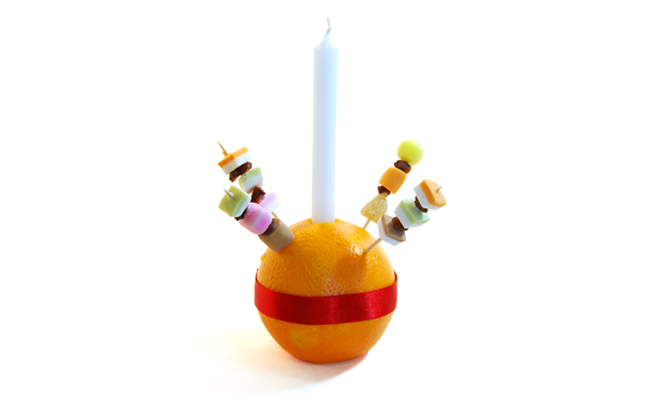Jumble sales of the apocalypse: Christingle - Reform Magazine
Simon Jenkins ponders Christingle
A few days before Christmas, a woman posted on Mumsnet.com in a state of utter bafflement: ‘A satsuma, a candle, two raisins, a sweet, four cocktail sticks and a peanut … what?’ Her daughter had just come home from church school ‘with the above items in a bag, and is on about putting the candle in the satsuma, and gluing on the sweet and raisins. She then is supposed to light the candle every day. Any idea what she is on about or what it all means?’ Another mum sympathised: ‘What on earth have jelly babies stuck in oranges got to do with Jesus?’
Christians these days have a lot on their hands with unbelievers asking difficult questions such as: ‘If God is a God of love, why is Songs of Praise still on the telly?’ So it’s something of a trial at Christmas when you also have to explain the connection between Jesus and jelly babies. How did it come to this?
The Christingle, cause of mystification on Mumsnet and focus of children’s services in December, is a curious beast. Its cocktail sticks, tin foil, candle and bits of ribbon (not to mention jelly babies) all lashed together on an orange, looks like an out of control Sputnik that’s got tangled up in a load of space junk and then caught fire. Its eccentric appearance is matched by its fruit and nut symbolism. It can’t seem to make up its mind which season of the Church year it’s talking about – a bit like a cantankerous uncle who won’t pick a lane on the motorway, despite the kindly blasts on the horn of other drivers. The red ribbon is for the blood Jesus shed on the cross, so that’s … um … Easter. Ditto for the tin foil, which is for the crucifixion nails. The bits of food impaled on the cocktail sticks are for the fruits of the earth, which is, well, Harvest. And the four cocktail sticks themselves symbolise the four seasons, which is Vivaldi. So remind me, someone: how in the name of Bassetts jelly babies is this meant to be a Christmas thing?
The Christingle is a surprisingly recent arrival in Church history. Its ingredients didn’t emerge miraculously from the mists of time-honoured tradition, but were brought together in 1968 by Mr John Pensom, a Children’s Society fundraiser, who was rather a character. When he died in 2006, the Church Times obituary revealed that on his letterhead he had once styled himself as John Pensom DGO. He admitted to friends that the DGO was in fact that well-known honour, the Damned Good Organiser. As things turned out, Mr Pensom needn’t have bothered about gongs and awards. That’s because his fruit-based marvel was enthusiastically embraced by British churches, and he became affectionately known as Mr Christingle, which is a lot better than having a DGO.
Admittedly, John Pensom wasn’t creating ex nihilo. He adapted his idea from a Moravian bishop, Johannes de Watteville, who gave children candles wrapped in a red ribbon for a service in Christmas 1747. How and when de Watteville’s simple idea transmogrified into the bloated Holy Orange of the present day is not hard to fathom. In the late 1960s and early 70s, every middle-class party featured a cheese and pineapple hedgehog, which was half a grapefruit covered in tin foil and bristling with cocktail sticks, with big chunks of cheddar and tinned pineapple skewered on the spikes. You don’t have to be Clouseau to spot that the Christingle is basically the love child of Christmas and terrible 70s party snacks. It’s a miracle that Twiglets weren’t added to symbolise the wood of Noah’s Ark.
The 50th anniversary of the Christingle is coming up in 2018, and it’s not too early for churches to carry out an upgrade to the Flaming Sputnik. Yes, it’s time to change the fruit and let another item from the supermarket trolley point the way to Bethlehem.
My nomination is for the Christingle banana, a fruit with some solid doctrine behind it. Banana skins are hazardous when dropped, and that reminds us of Adam and Eve slipping up over a fruit. Bananas are yellow, the colour of gold, the fi rst of Baby Jesus’ presents. The banana looks like a boomerang, reminding us Jesus will return a bit unexpectedly. And bananas are smile-shaped, just like people smiling at Christmas parties as they’re offered mulled wine, even though they’re screaming inside.
The Christingle banana. It could just be the most random and ridiculous church idea ever, except for the Christingle orange.
___
This article was published in the December 2016/January 2017 edition of Reform.












Submit a Comment